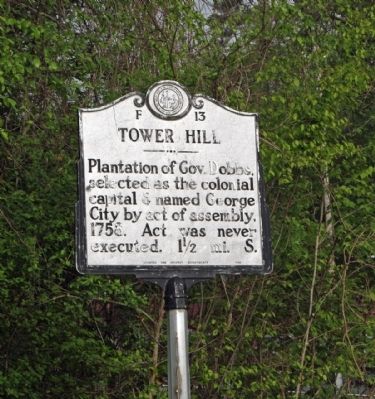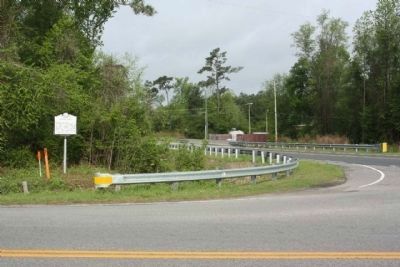Near Kinston in Lenoir County, North Carolina — The American South (South Atlantic)
Tower Hill
Erected 1965 by Archives and Highway Departments. (Marker Number F-13.)
Topics and series. This historical marker is listed in these topic lists: Colonial Era • Settlements & Settlers. In addition, it is included in the North Carolina Division of Archives and History series list. A significant historical year for this entry is 1758.
Location. 35° 17.764′ N, 77° 31.398′ W. Marker is near Kinston, North Carolina, in Lenoir County. Marker is on Tower Hill Road (State Highway 1810) near State Highway 55, on the right when traveling south. Touch for map. Marker is at or near this postal address: 1348 Tower Hill Rd, Kinston NC 28501, United States of America. Touch for directions.
Other nearby markers. At least 8 other markers are within 5 miles of this marker, measured as the crow flies. 1951 Walkout (approx. 3.4 miles away); Birth of Funk (approx. 4 miles away); Kinston Sit-Ins (approx. 4.1 miles away); The Town Of Kingston (approx. 4.1 miles away); Lenoir County WW I and WW II Memorial (approx. 4.1 miles away); In Honor and Remembrance (approx. 4.1 miles away); CSS Neuse (approx. 4.1 miles away); Caswell (approx. 4.1 miles away). Touch for a list and map of all markers in Kinston.
Regarding Tower Hill. Arthur Dobbs, named Royal Governor of North Carolina in 1753, arrived on the colony’s soil the following year at the age of sixty-six. A longtime bureaucrat, Dobbs had served as surveyor general of Ireland, and was responsible for the immigration of nearly 500 Irish Protestants to North Carolina.
Prior to arriving in North Carolina, Dobbs had met with Virginia and Maryland authorities in Williamsburg concerning a proposal to unite against the French. Notified of the lack of arms and equipment in North Carolina, Dobbs brought with him a determination to re-equip the colony’s militia and militarize the western frontier. Because of his actions, North Carolina was initially prepared for the French and Indian War that erupted shortly after his arrival. Upon his initiative the colony constructed Fort Dobbs to protect the frontier from incursions by the Cherokee and French.
Keenly aware of divisions within the colony’s Albemarle and Cape Fear factions, Dobbs proposed the establishment of a provincial capital in Kingston (modern-day Kinston). In December 1758 the assembly put forth a measure to purchase 850 acres “upon the plantation Tower Hill” from Dobbs at the price of £450 sterling. The capital intended to be built upon the land was to be called “George City” in honor of the King, and include “a governor’s house, house for assembly and office for the secretary to
be built with all possible expedition.” The act was never executed, and by 1762 Dobbs was petitioning the King for redress, stating that the “land was found to be unfit” and that since it had sat idly he “had not gained any production from it.” In 1763, the assembly had recommended that the proposed capital instead be built at New Bern.
Dobbs himself had settled at a plantation near Brunswick called Russellborough. Frustrated with the infighting in the colony, Dobbs received a leave of absence in 1764, but died on March 24, 1765, shortly before his proposed departure for Ireland. He was buried at St. Phillips Church in Brunswick. The new governor, William Tryon, agreed to have the colonial capital placed in New Bern, and Tryon Palace was built under the supervision of architect John Hawks between 1767 and 1770. (North Carolina Office of Archives & History — Department of Cultural Resources)
Credits. This page was last revised on June 30, 2021. It was originally submitted on May 25, 2013, by Mike Stroud of Bluffton, South Carolina. This page has been viewed 914 times since then and 92 times this year. Photos: 1, 2. submitted on May 27, 2013, by Mike Stroud of Bluffton, South Carolina.

